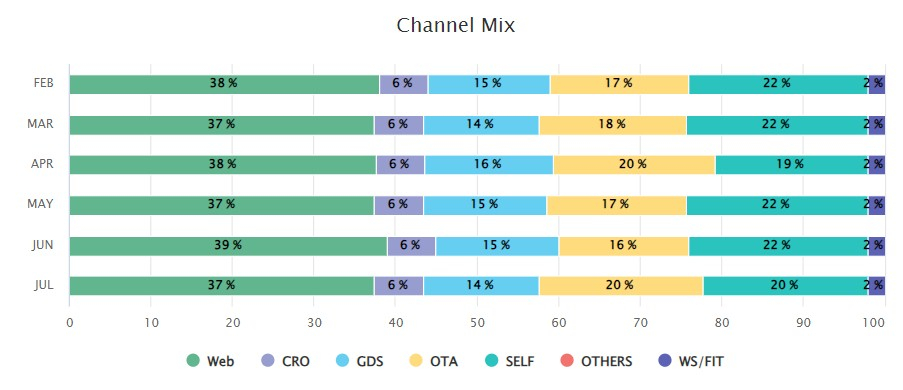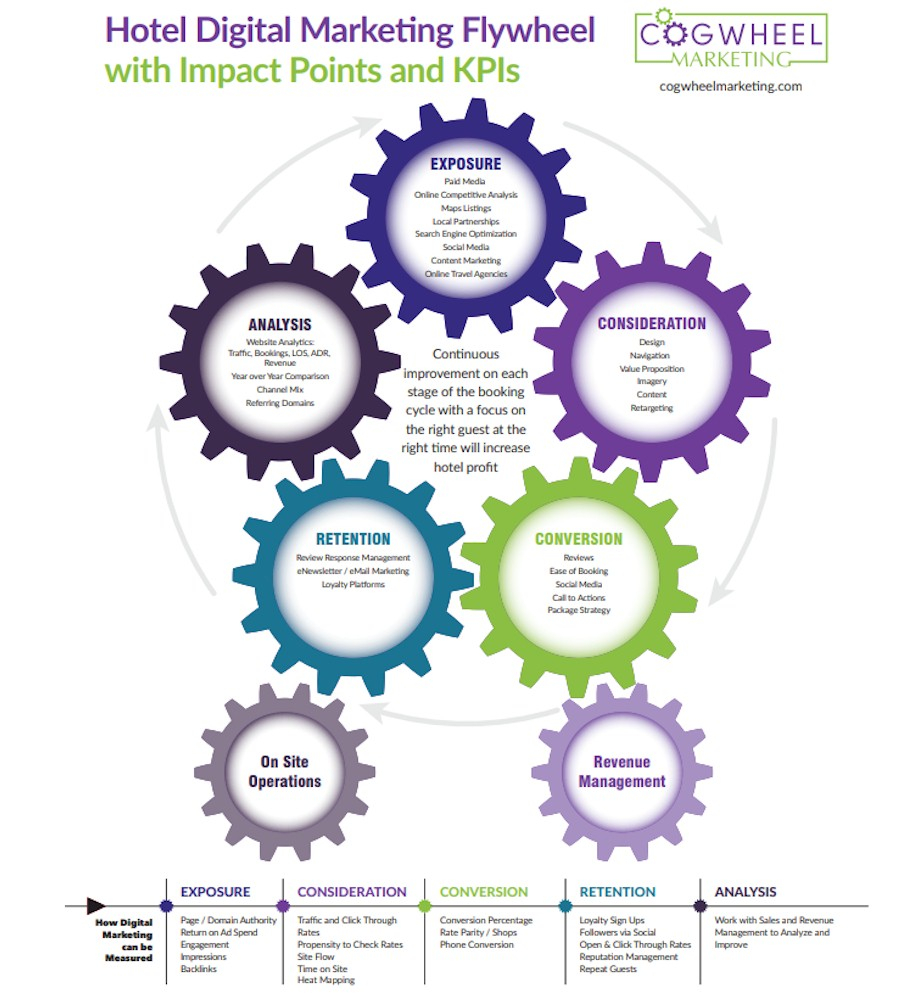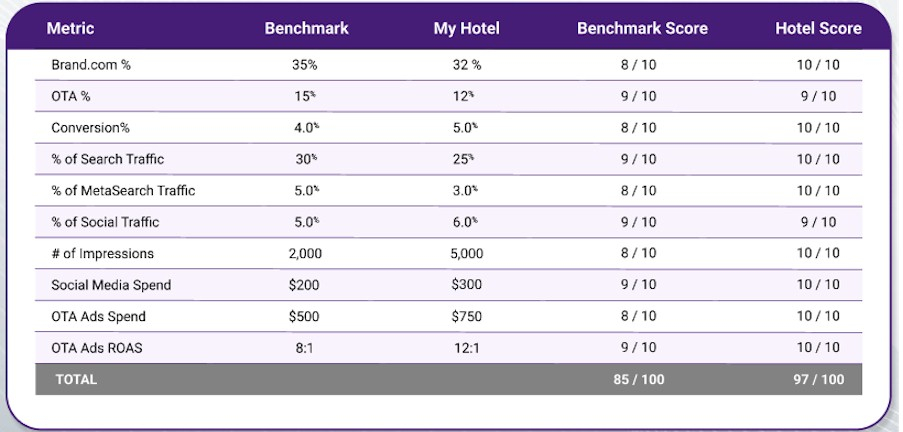In today’s digital age, businesses inside and outside the hospitality industry are generating more data than ever before.
This data is a valuable asset, and should be used to gain insights into customer behavior and make better decisions about marketing campaigns and the customer journey.
Owners regularly receive digital marketing performance reports or reports from their marketing agency and the next question is: “Is this good or bad?”
Many management companies and ownership groups spend far too much time aggregating data and not enough time creating action plans from the analysis of that data.
If you are lucky enough to have access to large amounts of data, big data can also be overwhelming you don’t know where to start. There is so much data available that it can be difficult to know where to start.
What Can You Do with Big Data for Digital Marketing?
There are a number of ways that big data analytics can be used to improve digital marketing performance and total online presence. Big data analytics can be used to see what is working and what is not, and make adjustments as needed.
By using the right data, the data can guide you toward strategic shifts or facilitate a better understanding of the gaps.
- Reallocate marketing budgets more effectively and reach the right personas with their messages.
- Track campaign performance on various platforms and channels.
- Perform a website conversion analysis.
- Create a better balance between organic and paid efforts.
- Ensure fair share to your website or that you are not overly reliant on 3rd party channels.
The Incorrect Assumption in Comparing Your Hotel’s Website Performance to Itself
Traditionally, hoteliers have primarily focused on a hotel’s website performance against itself year over year to determine positive or negative trends.
But, having your hotel be consistently available across locations online means bringing in more data points to make sense of what is good and what is bad.
For example, your website year-to-date has made $400K+ and that is 10% higher than the same time last year. While the percentage increase is positive, was the baseline good?
Ideally, you would look at your website’s (or brand.com’s) contribution against similar hotels to know if your website is getting its fair share.
Where Guests Can Find Your Hotel Online
It is imperative to understand the buyer’s journey is complex and potential guests are doing massive amounts of research before selecting not only a hotel, but also the channel or site with which to make that transaction.
We have to look at how your hotel sits on the shelf within these arenas as well:
- OTAs like Expedia and Booking.com
- Social Media
- Reviews
Then, we have to understand they are all interconnected and cannot be assessed in a silo. For example, if you have poor reviews, throwing money into Google Ads will likely yield less than the desired results.
Different Ways to Benchmark Your Hotel’s Digital Data
In addition to the above action items, big data analytics is used to benchmark your hotel’s performance against other hotels. This can be done by comparing your hotel’s performance to:
- A weighted historical average: This is a benchmark that takes into account your hotel’s historical performance, preferably with multiple years of data.
- Your portfolio: This is a benchmark that compares your hotel’s performance to the performance of other hotels in your company’s portfolio.
- Category hotels: This is a benchmark that compares your hotel’s performance to the performance of other hotels in the same category.
Category hotels can be a valuable benchmark when you want to see how similar hotels perform online. Most hotels can be grouped into economy, extended stay, limited service (no meeting space, no F&B), select service (F&B and meeting space), select service luxury (meeting space and F&B), full service, full service luxury, resort, and convention.
Similar to a STAR report but for marketing, by benchmarking your hotel’s performance, you can identify areas where you are doing well and areas where you can improve. While a STAR report benchmarks your hotel against select hotels in a given market, the digital landscape of offerings is much larger than the handful of hotels in your STAR report. Additionally, like hotels, tend to showcase similar metrics in the online space. Understanding this information can be used to make better decisions about your digital marketing campaigns and to improve your hotel’s overall performance.
Where to Get the Data to Benchmark
Mainstream hotel business intelligence tools pull data from the PMS (Property Management System).
The fallacy in using this data for digital marketing is that it implies the customer journey starts when a booking is made, when it actually started long before that. Which means sometimes our most important KPI becomes ROAS.
Ideally, you would look at your hotel’s online flywheel (or funnel) to ensure your hotel is in front of your target audience and that they then consider your hotel as a potential option when a destination has been selected.
Then, and only then, do we look at the booking and the point of sale. We, as hoteliers, have the tendency to credit whatever channel or effort was last used when making that booking.
The truth is there were many touch points prior to that, evolving their decision making. Therefore, this data needs to come from your CRS and other sites, not your PMS.
Create an Online Scorecard to Leverage Various Benchmarks
While different markets will vary in terms of revenue, ADR and number of rooms, we can normalize other digital marketing data points in terms of percentages and reach.
There are 10 KPIs you can use as a starting point to start benchmarking your hotel’s performance:
- Channel Mix > Brand.com Contribution Percentage. This metric tells us if you are getting your fair share of business through your website.
- Channel Mix > OTA Contribution Percentage. This metric tells us if we are overly reliant on 3rd party channels.
- Website Conversion. This metric tells us how well we convert potential customers once they land on our website.
- Brand.com > Percent of Search Traffic. Google (and other search engines) are still a major player in driving traffic to your hotel. This metric tells us how well the combined efforts of organic search and paid search perform and if balance exists.
- Brand.com > Percent of MetaSearch Traffic. By combining the efforts of both your organic and paid MetaSearch efforts, you can see if the funds dedicated to this channel are really moving the needle.
- Brand.com > Percent of Social Traffic. By combining your total social media traffic from organic and paid, you can determine if your efforts are creating interest. While this varies across hotels, it tends to normalize with like segment hotels.
- Social Media > Number of Impressions. While this metric is hard to put into a percentage, it does determine the exposure you get on social media. While much of social media content is consumed, but not acted on at that moment, this is a metric to balance against percent of social traffic and gauge views.
- Social Media Spend. This metric is important because many hotels still do not make any investments in their social media advertising. While you may not need to, it is important to understand what other hotels do, and the impact it has on impressions.
- OTA Ads > Spend. Whether Expedia Travel Ads or Booking Native Ads, OTA ads can contribute to your OTA contribution in Channel Mix. The spend can vary depending on the hotel size and market but still gives a baseline against ROAS.
- OTA Ads > ROAS. In reality, almost all hotels have a strong ROAS on OTA ads but this allows you to determine how your hotel stacks up.
Identifying Gaps in Your Hotel’s Online Presence
Big data is a powerful tool that helps businesses improve their digital marketing campaigns. By using big data analytics, businesses can track campaign performance, identify imbalances in channel mix, reallocate digital marketing funds and research gaps in their online presence. Businesses can also use big data to benchmark their performance against other hotels and to tell a story about their hotel, their customers and their online journey leading up to booking.
By following these tips and using a hotel digital marketing reporting tool, businesses can use big data to take action and implement informed decisions about their digital marketing that will improve their hotel’s overall performance and profitability.
Originally Published by HotelExecutive in October 2023






